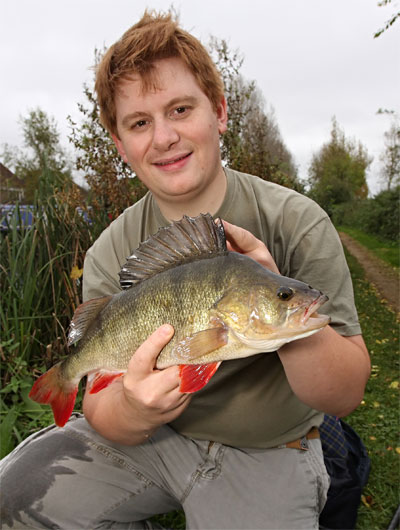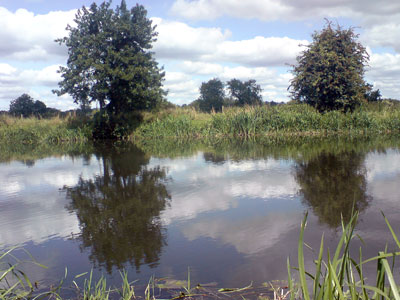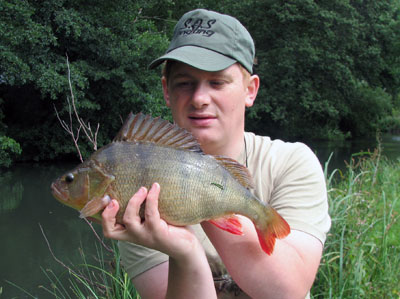In my last article (Kennet Perch Part 1) I touched on low atmospheric pressure. We all take this to be perfect perching conditions, perfect indeed for fishing bait but I wouldn’t rush out the door too quickly if we have a sudden drop overnight. Bide your time. If the pressure stays low, day two or, if we’re lucky, three, will see the river bulging with perch, ready to wolf down anything that moves – or at least, looks like it moved once.
Lobworms of course are the winners in this category, but prawns often eek out some good fish, especially on stretches with dense populations of crayfish. In fact, if you manage to fish with prawns during the crayfish’s shedding period, you are bound to clean up. The other and perhaps ultimate bait for big perch is a livebait – if you are not too squeamish and, of course, if venue rules permit. But please remember, only use baitfish from the same venue you are perch fishing. Livebaits could have a whole subcategory themselves, but for now, my personal top three are gudgeon, small bleak and small perch.
RIGS
We all know how to make rigs we are comfortable with, and I certainly wouldn’t for a second believe that anything added to my generic perch rigs has led me to any improvement in catching. I will however just give an idea of what works for me, in case it sparks further ideas for any of you that are perhaps trying big perch for the first time.
Waggler for canals

For the canals, I like to employ a waggler whenever possible. An insert at around 3 or 4 BB well shotted down is perfect for fishing lobs. In fact, the only time I may shy away from a float on the canal is when the water is so clear and the day is bright. Again, this is more of an issue of my own confidence than some groundbreaking finding. It’s just that big perch are second only to chub at spying things that don’t look quite right – and spotting a vertical line as they stick their noses on a juicy morsel will rarely result in a confident take. Some would perhaps employ a ‘laying on approach’ but I certainly wouldn’t recommend it – remember how tricky it is to retrieve your hook from a 2 oz perch that has absolutely savaged your double maggot offering while tempting roach or dace. Laying on could have the same potential but on a much larger scale.
Quivertip as an alternative, but watch the resistance
The alternative then is to fish with a quiver tip. I tend to prefer a straight running set up but I still can’t decide when canal fishing to use a very heavy or very light feeder/lead to get the least amount of resistance – something big perch are very wary of. I use both with large run-rings, but is it better to use a heavy weight that will not budge under pressure and just let the line move pretty freely? Or is it better to use a very small weight in order to use the lightest quiver tip possible, so as to offer the least resistance at that end of things? At the moment, they both have great success, so I shan’t go too mad yet. Ha! What am I talking about? I’m writing about perch as if they are the saviours of all humanity and I’m telling you I’m not mad. Hah!
Anyway, the common denominator, whether using heavy or light weights, is to fish the tip straight and a small amount of slack line held with a very light bobbin. Whether it be a washing up bottle top, a small deadbait pop up ball with a clip attached or a strip of tin foil, it doesn’t matter. As long as it is light and, of course, visual. This gives just the right amount of time to strike when the tip gives its first indication and enough time for the perch to get to the hook part of the worm. It is also a lot less frustrating than watching the tip leap all over the place as the perch tries to engulf the offering and finding that you have hit the bite too soon.
A Tip
A little tip to get the perch onto the hook in good time, is to place one whole lob on the shank and a half hooked at the bloody end. I find perch tend to hit this part first and it also gives you movement and a great deal of scent. My preferred hooks for worm fishing has to be the Drennan Specialist long shank in a 10 for dendras and from 8 to 6 for lobs. The Korda Specimen long shanks in a 12 are also pretty good. I’m also a firm believer in injecting a little air to pop those wriggling beauties up a touch.
Feed with a Sponge Soaked in Worm Juice!
On the coldest of days I prefer not to feed with maggot or chopped worm, I just want to get flavour into the water. I find it’s of great benefit to use a piece of sponge soaked in worm juice inside the feeder, even better, soil from a fresh mole hill, full of aminos – and dog poop if your not lucky, so watch out!
Livebaiting best with a float
 Livebaiting on a canal section is best (and more excitingly achieved) with a float. I find the newer, pellet style wagglers are ideal as they afford you enough weight to place down the line to keep the live fish in the lower third of the water, where it can be spied by all. It can also can help to keep the prey, especially bleak in a more concentrated area. Sometimes, if I know an area is pretty pike free, I will risk not using a trace of any sort. If I am fishing a new area, I will always use some of the multi-strand trace material, notably Drennan seven strand or it’s Fox counterpart. Both can easily be tied to a swivel and a hook with out much effort or bulkiness at all.
Livebaiting on a canal section is best (and more excitingly achieved) with a float. I find the newer, pellet style wagglers are ideal as they afford you enough weight to place down the line to keep the live fish in the lower third of the water, where it can be spied by all. It can also can help to keep the prey, especially bleak in a more concentrated area. Sometimes, if I know an area is pretty pike free, I will risk not using a trace of any sort. If I am fishing a new area, I will always use some of the multi-strand trace material, notably Drennan seven strand or it’s Fox counterpart. Both can easily be tied to a swivel and a hook with out much effort or bulkiness at all.
Livebaiting of this sort is real heart-racing stuff. The bait itself will settle down after a few minutes, but soon, if lucky, the float will move from left to right, back and forward as the baitfish sees the looming black, pearl-eyed, sail finned terrorist casually sneak up to him. It makes use of every available bit of cover on the way before making a mad final dash, tearing away and dragging the float under the water, and out of sight.
Perch come in from the rear
Perch tend to attack fish from the rear, as opposed to the pike, which likes to hit from the flank before turning its quarry to swallow it. This being the case, lip hooking is the tried and tested way, but of late, I have been using a long shanked hook and passing it through the bottom jaw and up through one of the nostrils, this has resulted in a lot less pulled strikes for some reason and I think it is to do with the hook point at times being above the bait fishes head, thus easily pricking the perch further into their cavernous mouths
Now, as far as I’m concerned, there are no great changes to these methods when fishing on more flowing stretches of the Kennet – though I have recently tended to favour the quivertip over the stick float or wagglier. This is more to do with worrying that a bait isn’t staying put long enough for the fish to decide to take it or not. There are of course days that this is not an issue, but unless you can see the perch for yourself and know that it will leap onto the bait as soon as it washes past, it can be very difficult to judge.
Livebaiting in running water
Livebaiting on rivers tends to have me using a rod of around 1 – 1.25lb TC, a very small and lightly geared bait runner and a heavier lead than is necessary to simply just hold bottom, and set on a big run ring fished in-line with a swivel. If possible, fish with the rod tip low to the water and pointing at the bait, have a fair bit of slack and your light bobbin holding it still, just off the bankside floor. This is easily achieved when fishing the nearside bank.
 I prefer a hooklength of 6 to 8 inches with a couple of inches of tubing beneath the swivel to prevent the bait fish causing no end of tangles, again, you get a pre warning when to expect a strike as your bobbin will leap all over the place as the little bleak or gudgeon tries its hardest to escape. The slack will soon be taken up and the bait runner can start whizzing away.
I prefer a hooklength of 6 to 8 inches with a couple of inches of tubing beneath the swivel to prevent the bait fish causing no end of tangles, again, you get a pre warning when to expect a strike as your bobbin will leap all over the place as the little bleak or gudgeon tries its hardest to escape. The slack will soon be taken up and the bait runner can start whizzing away.
Get to know your venue
To summarise then: Get to know a particular stretch of the Kennet well, be it canal or river. As long as it has a good mass of small fish and fry at the time of asking (check local match results). Identify half a dozen textbook perch swims; great patches of cabbage, knotty tree roots, overhanging brambles and tight rushes or reed beds are all good places to start. Don’t be tempted to rove around on your first few visits, dedicate the whole session to one particular swim before returning to a different one for the next visit.
Whatever you do, don’t lose heart if you start picking up perch in the 2-8 oz bracket. I can almost guarantee that a big perch may be only a few feet away. Likewise with crayfish, if you encounter many while fishing a spot, it generally means there are no active perch near. If this action stops however, you can take it that a big old footballer has moved into the vicinity and hopefully, very soon you will be face to face with the most charismatic of Kennet fishes.
Will Barnard










